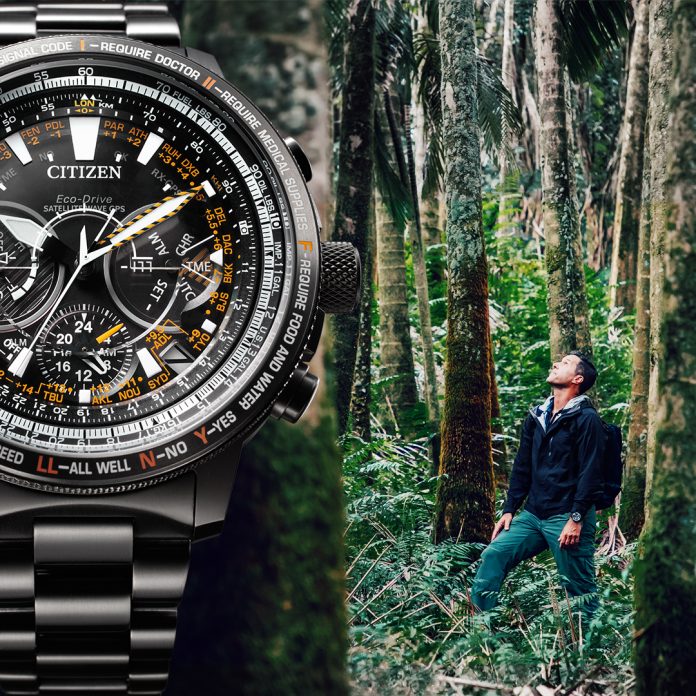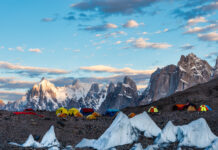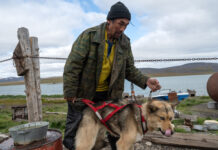Ecology Takes To The Air
Citizen’s PROMASTER line celebrates 30 years of adventure through tough terrains, ascending through crisp mountain air, diving in the deep blues, and up high in the sky. In conjunction with the festivities, limited edition PROMASTER model are here for your escapades – through the world’s expansive geography, on land and above.
 The Satellite Wave GPS PROMASTER Sky Series is a professional pilot watch. Inspired by cockpit instruments and heads-up displays, it features aviation scale and design using ground-air visual signal codes*6 to enhance the characteristics as a professional pilot watch. It also combines a rugged case and bold-looking multilayer face structure with five separate layers of mechanics, crafting a ground-breaking design structure by putting hands between base dial and clear dial that seems to float above. The unique bezel design features ground-air visual signal codes, and larger indexes and hands with luminescence and an orange colour accent to ensure greater visibility. To top it off, the 30th anniversary logo and serial number are stamped on the case back, so you know you have the real deal!
The Satellite Wave GPS PROMASTER Sky Series is a professional pilot watch. Inspired by cockpit instruments and heads-up displays, it features aviation scale and design using ground-air visual signal codes*6 to enhance the characteristics as a professional pilot watch. It also combines a rugged case and bold-looking multilayer face structure with five separate layers of mechanics, crafting a ground-breaking design structure by putting hands between base dial and clear dial that seems to float above. The unique bezel design features ground-air visual signal codes, and larger indexes and hands with luminescence and an orange colour accent to ensure greater visibility. To top it off, the 30th anniversary logo and serial number are stamped on the case back, so you know you have the real deal!
The watch also features high-end light-powered Eco-Drive SATELLITE WAVE GPS movement Cal. F990, and shows the time in two different world time zones simultaneously, switching from home time and local time in one instant step.
It receives a time signal from a GPS satellite in a minimum of 3 seconds, and corrects time and calendar by syncing with GPS satellites (for any 39 cities). The 1/1 second chronograph measures 24 hours and the Light-Level Indicator*5 detects and displays the intensity of light striking the dial in seven sensitivity levels. The Super Titanium™*7 comes with special surface hardening technology combining Duratect MRK and Duratect DLC that resists scratches and other damage.
 Now meet Dr Greg Asner, Airborne Ecologist. Greg is a global ecologist and earth explorer. He is the creator of the Global Airborne Observatory (GAO) – a one-of-a-kind airplane equipped with high powered lasers, imaging spectrometers, and supercomputers that can map remote landscapes all the way from rainforests to coral reefs.
Now meet Dr Greg Asner, Airborne Ecologist. Greg is a global ecologist and earth explorer. He is the creator of the Global Airborne Observatory (GAO) – a one-of-a-kind airplane equipped with high powered lasers, imaging spectrometers, and supercomputers that can map remote landscapes all the way from rainforests to coral reefs.

 Greg’s innovative technologies play a key role in monitoring the impacts of climate change, whether it is on mega-droughts in the Amazon Basin or coral-bleaching events in Hawaii. Governments and NGOs are increasingly turning to Greg for the data they need to make decisions on conservation and resource policy – decisions crucial to the future of our species and our planet.
Greg’s innovative technologies play a key role in monitoring the impacts of climate change, whether it is on mega-droughts in the Amazon Basin or coral-bleaching events in Hawaii. Governments and NGOs are increasingly turning to Greg for the data they need to make decisions on conservation and resource policy – decisions crucial to the future of our species and our planet.

 Greg and his team invented a technology called laser-guided imaging spectroscopy, or LGIS, which is based on fusing 3D laser-based data and spectral data. It fires two laser beams from the bottom of the plane, which sweep over the landscape and every time they touch something vegetative they return a few of the photons. That tells us the 3D structure of the canopy, and from that his team is able to calculate very accurately how much carbon is in the trees. That’s then fused with an amazing technology called imaging spectroscopy which enables them to see the spectrum of light in 427 channels. Using a technique that his team also invented called “spectranomics”, they can turn these spectral signatures into identifications of species. For trees, they average 80% accuracy worldwide, flying at 80 meters per second at 7,000 feet!
Greg and his team invented a technology called laser-guided imaging spectroscopy, or LGIS, which is based on fusing 3D laser-based data and spectral data. It fires two laser beams from the bottom of the plane, which sweep over the landscape and every time they touch something vegetative they return a few of the photons. That tells us the 3D structure of the canopy, and from that his team is able to calculate very accurately how much carbon is in the trees. That’s then fused with an amazing technology called imaging spectroscopy which enables them to see the spectrum of light in 427 channels. Using a technique that his team also invented called “spectranomics”, they can turn these spectral signatures into identifications of species. For trees, they average 80% accuracy worldwide, flying at 80 meters per second at 7,000 feet!
 Even without humans causing deforestation directly, tropical forests are changing under the indirect impacts of humans, which translates to climate change. And we know that – we see it happening. It’s expressed in something we call “hot drought”. This is a novel kind of process that in the paleo record, the scientific record, is extremely rare to non-existent, where extremely high temperatures and extremely low rainfall is an ordeal. It may persist for three or even six months and it causes these large swathes of trees to die. That’s a form of deforestation. They’re standing upright as ghosts or skeletons, for months to years, eventually they fall down and all of that carbon is decomposed and put back in the atmosphere as carbon dioxide.
Even without humans causing deforestation directly, tropical forests are changing under the indirect impacts of humans, which translates to climate change. And we know that – we see it happening. It’s expressed in something we call “hot drought”. This is a novel kind of process that in the paleo record, the scientific record, is extremely rare to non-existent, where extremely high temperatures and extremely low rainfall is an ordeal. It may persist for three or even six months and it causes these large swathes of trees to die. That’s a form of deforestation. They’re standing upright as ghosts or skeletons, for months to years, eventually they fall down and all of that carbon is decomposed and put back in the atmosphere as carbon dioxide.

There are only a few ecosystems on the planet that host most of the species. Rainforests are one of them: They’re these incredible webs of life that are historically self-sustaining. The interactions between organisms create sustainability, and the rainforests provide us with enormously important services. In terms of carbon storage, they keep a massive amount of carbon out of the atmosphere, which otherwise would exacerbate this warming problem that we have, and they have a really critical function in our global hydrologic system, influencing, for example, the rainfall that we get, say, in parts of the United States. Rainforests not only serve the people that live there and protect a huge amount of the earth’s biodiversity, they regulate some of the critical functions of the entire earth system, especially carbon and water.
“It’s not too late [to save the world],” Greg says. “You hear a lot about deforestation in the tropics, like in the Amazon Basin. It’s true we’re losing vast areas of the Amazonian rainforest. The good news is that those losses pale in comparison to what’s still remaining in those forests. The forest is vast. We still have time to make the right decisions to save what’s left. The same goes for coral reefs. We hear all about coral reefs dying worldwide. In Hawaii in 2015, we had a heat wave that killed about 30% of our corals. Coral reefs are in critical danger today. But we still have vast areas of coral reef that are still intact and we can still do something about that.”
You can read more about Greg as well as Citizen’s #SavetheBEYOND campaign here, or view this stunning product (and others in the PROMASTER series!) here.











